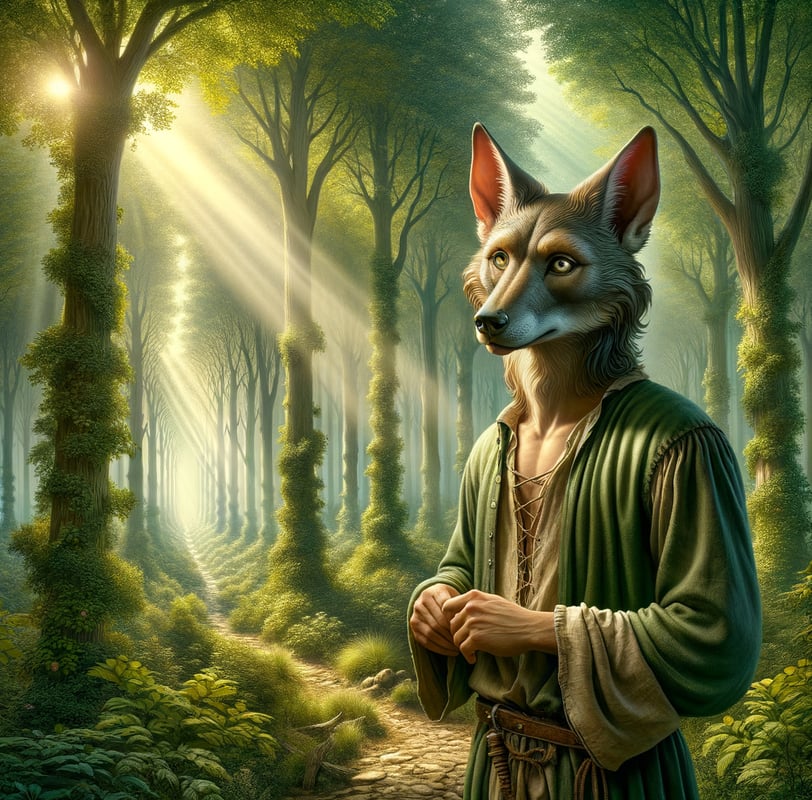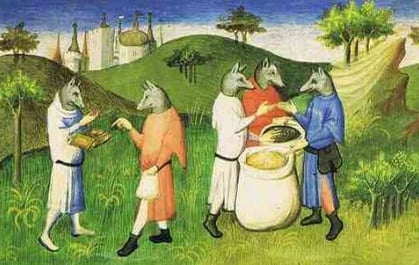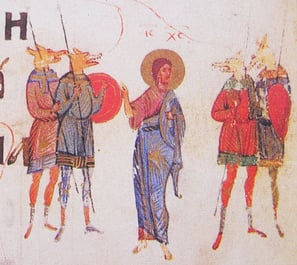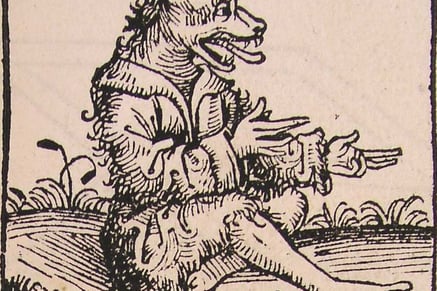The Mystique of Cynocephaly
Unveiling the History and Myths
HISTORY
Lily
3/9/20258 min read


Understanding Cynocephaly / Cynocephali: Definition and Origins
Cynocephaly refers to the mythical notion of beings possessing the body of a human and the head of a dog. The term originates from the Greek words "kyon," meaning dog, and "kephalē," meaning head. As an intriguing construct, cynocephaly has captivated various cultures from antiquity to modern times, often embodying complex themes of duality and the Other. The representation of such beings presents a rich tapestry of human imagination, intertwining elements of mythology, psychology, and societal beliefs.
Historically, cynocephalic figures have appeared in various cultures, notably within ancient Egyptian, Greek, and Indian mythologies, which serves to demonstrate the pervasive nature of this imagery. In ancient Egypt, for instance, the god Anubis is frequently depicted as having a canine head, symbolizing his role as a guardian of the afterlife and guide to the deceased. Such representations align with the broader understanding of death, memory, and transformation intrinsic to Egyptian culture.
In Greek mythology, tales of cynocephalic beings are less frequent but can be found within the context of legends and folklore, often conveying themes of loyalty, protection, and the relationships between humans and animals. The link between cynocephaly and artistry is notable, with various artworks influencing literature and oral narratives throughout history. They function as cultural symbols embodying the fears and aspirations of societies, reflecting how these hybrid beings often embody the conflicts between civilization and nature, intuition and reason.
Furthermore, the manifestation of cynocephalic figures in art and literature serves to bridge the gap between the sacred and profane, revealing deeper psychological and existential inquiries about human identity and animalistic instincts. This blend of origins and definitions highlights the significance of cynocephaly in our shared cultural narrative, marking it as a phenomenon worth exploring in historical and contemporary contexts.
Historical Accounts of Cynocephalic Beings
Cynocephaly, the mythological condition of having the head of a dog or resembling a canine figure, has intrigued cultures across the globe. Ancient texts provide a rich tapestry of historical narratives and interpretations surrounding these beings. One of the earliest references emerges from Greco-Roman literature, where cynocephalic creatures often represented both hybridization and the boundaries between human and animal forms. The Greek historian Herodotus famously described a tribe of dog-headed men living in the region of India, which, despite its fantastical elements, indicates the extent to which these beings captured the human imagination.
In the realm of medieval art, cynocephalic beings were frequently depicted in manuscripts and sculpture. These artistic representations served multifaceted purposes, from exploring allegorical themes to expressing societal fears and moral lessons. For instance, in the illuminated manuscripts of the Middle Ages, these figures often appeared alongside saints, suggesting a safeguard against evil or embodying the duality of human nature. The presence of cynocephalic beings in medieval art subtly reflects the cultural narratives that painted them, varying significantly across different regions and traditions.
Cynocephaly in Literature and Mythology
Cynocephaly, the mythological concept of dog-headed humanoids, has captured the imagination of various civilizations throughout history. These figures, known as cynocephali, appear in literature and mythology across different cultures, symbolizing a blend of human intellect and animalistic traits. The presence of cynocephalus characters can be traced back to ancient sources, where they often represented the connection between humanity and nature, as well as the exploration of the boundaries of human identity.
In ancient Egyptian mythology, for example, the god Anubis is commonly depicted with a jackal head, embodying the themes of death and the afterlife. Anubis serves as a guide to the dead, highlighting the significance of canine imagery in spiritual contexts. Similarly, in Greek literature, cynocephali appear in the tales of the Argonauts, where they are portrayed as guardians of the land. These representations often carry deeper implications, such as loyalty, protection, and the blurring of lines between civilization and savagery.
The depiction of cynocephalic figures is not limited to ancient texts. In medieval bestiaries, the cynocephalus is often described as a monstrous being that embodies the fears and curiosities of humanity regarding the unknown. Such representations serve not only as fantastical elements in storytelling but also as reflections of societal values and norms pertaining to the animal-human dichotomy. Furthermore, comparisons can be drawn between cynocephali and similar mythological beings in various cultures, such as the Indian figure of Hanuman, who possesses a monkey-like appearance and showcases divine attributes. This cross-cultural exploration reveals the underlying archetypes shared among different civilizations and reinforces the concept of anthropomorphism in mythology.
Through these literary and mythological portrayals, cynocephaly invites deeper consideration of the human condition and the theorizations surrounding identity, transformation, and the characteristics shared between humans and animals. It also highlights the intricate tapestry of folklore that enriches our understanding of cultural heritage and the enduring allure of mythological themes.
Cynocephaly and Its Place in Witchcraft and Folklore
The concept of cynocephaly, referring to beings that possess a human body with the head of a dog, has deep roots in various mythologies and folklore across cultures. In European folklore, cynocephaly became linked with the supernatural, often portrayed as harbingers of magic or ominous forces. These creatures were frequently associated with witchcraft, serving as symbols of the unknown and the inexplicable. The depiction of cynocephalic beings in medieval stories often drew on societal fears surrounding witches and magicians, reflecting the tumultuous relationship between humanity and the perceived mystical forces of nature.
Cynocephalic figures were sometimes believed to be servants of witches or embodiments of their dark powers, intertwining their existence with themes of sorcery and the occult. In this regard, they were not merely creatures of mythology but rather representations of the societal anxieties regarding the practice of witchcraft. The presence of these beings in folklore often suggested a moral or cautionary tale, warning the populace of the dangers that come with straying too close to the magical or supernatural. Additionally, the witch hunts that spanned several centuries in Europe heightened the fear surrounding cynocephaly and further entrenched their association with malevolent magic.
The connection between cynocephalic figures and witchcraft extends beyond mere appearance; it encompasses attitudes towards the otherworldly and those who practiced it. Such beings were often portrayed in a dualistic light, admired for their mystical attributes while simultaneously feared for their potential to disrupt societal norms. This duality reflects a broader narrative within folklore where fear and reverence coalesce, providing insight into the historical perception of magic as both a force for good and evil. Overall, cynocephaly’s place in witchcraft narratives underscores the complex relationship between humanity, magic, and the supernatural, reinforcing the notion that such creatures are deeply embedded in the cultural psyche.
The Symbolism Behind Cynocephalic Figures
The concept of cynocephaly, or the representation of humans with canine features, has deep roots in various cultures and mythologies. Symbolically, these figures often embody the duality of nature, illustrating the delicate balance between humanity and animality. This duality evokes a complex interplay between the divine and the monstrous, where cynocephalic beings can be seen as intermediaries possessing qualities of both realms. For instance, in ancient Egyptian mythology, the god Anubis, depicted with a jackal's head, serves as a protector of the dead, reflecting themes of mortality and the afterlife while embodying the wild and untamed aspects of nature.
The intersection of humanity and animality portrayed by cynocephalic figures invites numerous interpretations. These symbols may represent the primal instincts inherent in human nature, suggesting that our base instincts are never far from the surface. In various mythological narratives, the cynocephalic form often highlights traits such as loyalty, protection, and the guardianship of thresholds, particularly in the context of death and the afterlife. Such representations encourage introspection about the nature of identity and the intrinsic attributes that define what it means to be human.
Moreover, the psychological implications of these symbols within historical belief systems reveal societal attitudes toward the coexistence of civility and savagery. In times of upheaval or uncertainty, cynocephalic figures often represented fears of chaos and the loss of civility. Their presence in folklore and mythology acted as a cautionary tale about the consequences of disregarding our innate animalistic tendencies. By reflecting on these themes and their manifestations across cultures, we gain deeper insights into the complexities of the human psyche and the cultural narratives that have shaped our understanding of the world around us.
Cynocephaly in Modern Culture
The concept of cynocephaly, characterized by beings with the head of a dog and the body of a human, has traveled through centuries, experiencing reinterpretations and adaptations that reflect the evolving nature of cultural narratives. In contemporary culture, cynocephaly resurfaces notably in literature, cinema, and other forms of popular media. These modern portrayals often juxtapose the historical depictions of cynocephalic figures with fresh interpretations that resonate with current societal themes.
In literature, cynocephaly appears as symbolic figures representing untamed instincts or the duality of civilization versus nature. Recent novels that feature characters inspired by this mythical being often explore complex themes of identity, belonging, and the boundaries between humanity and animalistic behavior. Such narratives may evoke a sense of intrigue, compelling readers to examine their perceptions of what it means to be "human" in a world that increasingly brings to light questions of morality and ethics.
In the realm of film, cynocephalic characters often serve as metaphors for the struggles against societal norms. Films and television shows depicting such beings delve into issues of acceptance, prejudice, and the fear of the unknown, suggesting that these narratives hold a mirror to humanity itself. For instance, portrayals in animated series and graphic novels frequently infuse humor, yet they also address deeper existential questions, revealing the complexity behind the cynocephalic figure as more than merely a monster or antagonist.
Moreover, in video games, the integration of cynocephalic elements manifests through character design and storytelling mechanics that challenge players' perspectives on humanity’s relationship with the animal kingdom. Today's cynocephalic entities reflect an enduring fascination, blending ancient myths with modern storytelling techniques. This fusion continues to shape and redefine cynocephaly, ensuring its relevance and legacy in contemporary myth-making.
Conclusion: The Legacy of Cynocephaly
The concept of cynocephaly, or dog-headed beings, has transcended time and culture, forming a fascinating intersection of mythology, folklore, and human imagination. This intriguing motif, found in various ancient texts and artistic representations, has sparked interest among scholars and enthusiasts alike, leading to an enduring legacy in cultural narratives. Throughout history, cynocephalic figures have served as symbols of otherness, embodying the tension between the familiar and the strange, a theme that resonates deeply in human storytelling.
From the mythological accounts of the Egyptian Anubis to the references in medieval bestiaries, the portrayal of cynocephalic beings has often reflected societal values and anxieties. These figures serve not only as subjects of curiosity but also as lenses through which we can examine humanity's relationship with the animal kingdom and the boundaries of identity. The duality of human and animal traits in cynocephaly invites introspection about our own nature and the blurred lines that exist between civilization and the wild.
Moreover, understanding the prevalence and significance of cynocephaly offers valuable insights into broader themes in mythology and folklore. By studying such figures, we can better appreciate the complexities of human belief systems and the ways in which they manifest in art and literature. The representation of cynocephalic beings reflects cultural tensions surrounding conformity, fear of the unknown, and the evolution of societal norms. Thus, the mystique of cynocephaly remains potent, enriching our comprehension of ancient civilizations and their collective memories.
In conclusion, the legacy of cynocephaly endures not only in historical texts but also in modern interpretations that explore the depths of human creativity and cultural reflection. The ongoing research and fascination with these figures highlight the importance of engaging with mythological constructs to enhance our understanding of humanity and its narrative traditions.






Magick
Explore the enchanting realm of Witchcraft today.
©Lilyopatra 2025. All rights reserved.
All SALES ARE FINAL, and we appreciate your understanding of our site policy. Once a purchase is made, we cannot offer refunds or exchanges for any items. This policy ensures that we can maintain low prices and high-quality products for our customers. We encourage you to thoroughly review product descriptions, sizes, and specifications before completing your purchase to avoid any dissatisfaction. If you have any questions about an item, please reach out to our customer service team prior to ordering. We value your business and are committed to providing a positive shopping experience, but once a transaction is finalized, we are unable to accommodate any changes or returns.
Thank you for your cooperation and support.

